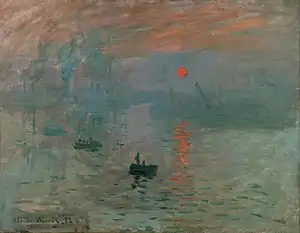Canadian Impressionism
Canadian Impressionism is a subclass of Impressionist art which had its origin in French Impressionism. Guy Wildenstein of the Wildenstein Institute in Paris states in the foreword of A.K. Prakash's Impressionism in Canada: A Journey of Rediscovery that Canadian impressionism consists of "the Canadian artists who gleaned much from the French but, in their improvisations, managed to transmute what they learned into an art reflecting the aesthetic concerns of their compatriots and the times in which they lived and worked".[1] The early Canadian Impressionist painters belong in the "Group of who?" as coined by James Adams of The Globe and Mail.[2]
History
Canada's first affair with Impressionism occurred in 1892 in Montreal at W. Scott & Sons' premises. Eight paintings were exhibited including works of Monet, Renoir, Pissarro and Sisley.[3] Montreal became the epicentre of Impressionism in Canada at the turn of the twentieth century.[4] Numerous Canadian artists encountered Impressionism during their travels and studies in Europe, including Montreal-based William Brymner (1855–1925)[5] and Helen McNicoll (1879–1915),[6] and West Coast painter Emily Carr.[7]
Brymner was one of the earliest Canadian artists to study in Paris, from 1878 to 1880;[8] there he was introduced to the Impressionist works of contemporary French artists.[9] In the mid-1890s, Brymner gave public talks about Impressionism. One took place in March 1896, for the Women’s Art Association of Canada at the YMCA in Montreal. He gave another in April 1897, one of the special lectures he occasionally organized in his role as master of the School at the Art Association of Montreal from 1886 to 1921.[10] Brymner taught numerous artists who became key figures in modern Canadian art, and without him, the Impressionist movement would not have taken root in the country.[11]
One of Brymner's students at the Art Association of Montreal, McNicoll played a significant role in popularizing Impressionism in Canada.[12] Following Brymner's advice to his students to travel to Europe to further their education, McNicoll moved to London in 1902.[13] There, she may have visited the large exhibition of works by the French Impressionists organized by French art dealer Paul Durand-Ruel at the Grafton Galleries in London in 1905.[14] McNicoll fully embraced the principles of French Impressionism, more so than any other Canadian artist of her time.[15]
Canadian Impressionism was first recognized as a historical movement in Canadian Art in 1950.[16]
Artists
Exhibitions
In 2019, the show Canada and Impressionism: New Horizons, curated by the National Gallery of Canada, visited Munich, Lausanne, and Montpellier.[21] A second, somewhat modified exhibition, opened in Ottawa at the National Gallery in February 2022.[22]
References
- Prakash. 2015. p. xxv
- Adams, James (December 5, 2014). "Group of who? A new book paints the fullest picture yet of Canada's vision of Impressionism". The Globe and Mail. The Globe and Mail Inc.
- Pohl, John (February 5, 2015). "Visual arts: Montreal played key role in spread of Impressionism to Canada". Montreal Gazette. Postmedia Network Inc.
- Burton, Samantha (2017). Helen McNicoll: Life & Work. Toronto: Art Canada Institute. ISBN 978-1-4871-0152-7.
- Anderson, Jocelyn (2020). William Brymner: Life & Work. Toronto: Art Canada Institute. ISBN 978-1-4871-0238-8.
- Burton, Samantha (2017). Helen McNicoll: Life & Work. Toronto: Art Canada Institute. ISBN 978-1-4871-0152-7.
- Baldissera, Lisa (2015). Emily Carr: Life & Work. Toronto: Art Canada Institute. ISBN 978-1-4871-0044-5.
- Burton, Samantha (2017). Helen McNicoll: Life & Work. Toronto: Art Canada Institute. ISBN 978-1-4871-0152-7.
- Anderson, Jocelyn (2020). William Brymner: Life & Work. Toronto: Art Canada Institute. ISBN 978-1-4871-0238-8.
- Anderson, Jocelyn (2020). William Brymner: Life & Work. Toronto: Art Canada Institute. ISBN 978-1-4871-0238-8.
- Anderson, Jocelyn (2020). William Brymner: Life & Work. Toronto: Art Canada Institute. ISBN 978-1-4871-0238-8.
- Burton, Samantha (2017). Helen McNicoll: Life & Work. Toronto: Art Canada Institute. ISBN 978-1-4871-0152-7.
- Burton, Samantha (2020). Helen McNicoll: Life & Work. Toronto: Art Canada Institute. ISBN 978-1-4871-0152-7.
- Burton, Samantha (2017). Helen McNicoll: Life & Work. Toronto: Art Canada Institute. ISBN 978-1-4871-0152-7.
- Burton, Samantha (2017). Helen McNicoll: Life & Work. Toronto: Art Canada Institute. ISBN 978-1-4871-0152-7.
- Prakash. 2015. p. 11
- Kerr, Matthew (25 July 2019). "French Canadians – how Impressionism caught on in the Great White North". Apollo magazine. Retrieved 2 February 2020.
- "Visions of Light and Air: Canadian Impressionism, 1885-1920". Americas Society / Council of the Americas. Retrieved 23 May 2017.
- Prakash. 2015. p. 491ff
- Prakash. 2015. p. 418ff
- Sandals, Leah (24 July 2019). "Canadian Impressionism Show Offers Unprecedented View of Overlooked Art-Historical Chapter". canadianart. Retrieved 2 February 2020.
- MacGregor, Roy (29 January 2022). "National Gallery to open special exhibition celebrating the Canadian Impressionists". The Globe and Mail. Retrieved 30 January 2022.
Sources
- Anderson, Jocelyn. William Brymner: Life & Work. Toronto: Art Canada Institute, 2020. ISBN 978-1-4871-0238-8
- Baldissera, Lisa. Emily Carr: Life & Work. Toronto: Art Canada Institute, 2015. ISBN 978-1-4871-0044-5
- Burton, Samantha. Helen McNicoll: Life & Work. Toronto: Art Canada Institute, 2017. ISBN 978-1-4871-0152-7
- Prakash, A.K. Impressionism in Canada: A Journey of Rediscovery. Stuttgart: Arnoldsche Art Publishers, 2015. ISBN 978-3-89790-427-9
- Lowrey, Carol, Visions of Light and Air: Canadian Impressionism, 1885-1920, Americas Society, 1996.
